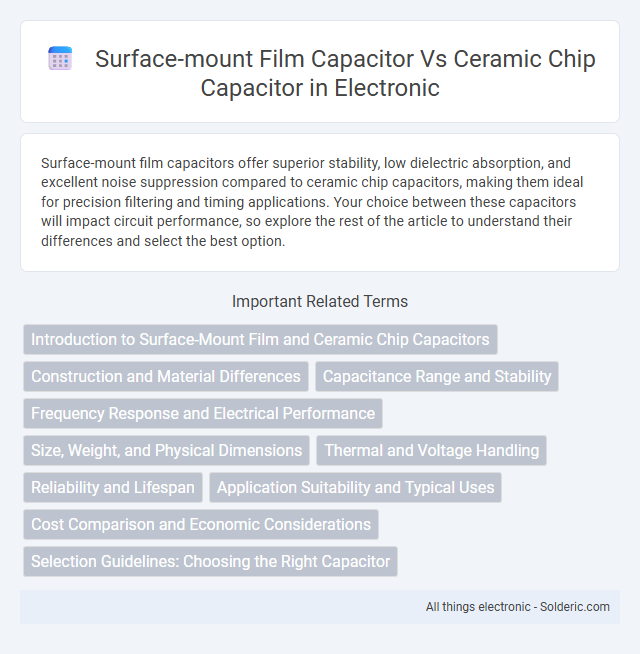Surface-mount film capacitors offer superior stability, low dielectric absorption, and excellent noise suppression compared to ceramic chip capacitors, making them ideal for precision filtering and timing applications. Your choice between these capacitors will impact circuit performance, so explore the rest of the article to understand their differences and select the best option.
Comparison Table
| Feature | Surface-Mount Film Capacitor | Ceramic Chip Capacitor |
|---|---|---|
| Dielectric Material | Polypropylene, Polyester, or similar polymer films | Barium Titanate or other ceramic materials |
| Capacitance Range | 1 pF to 10 uF | 0.1 pF to 100 uF |
| Voltage Rating | Up to 1000 V or higher | Typically up to 500 V |
| Tolerance | +-1% to +-10% | +-5% to +-20% |
| Temperature Stability | Excellent, low drift | Varies, generally less stable (NP0/C0G best) |
| ESR (Equivalent Series Resistance) | Low ESR | Higher ESR compared to film |
| Size | Larger for equivalent capacitance | Compact; popular in high-density PCB designs |
| Applications | Precision filtering, timing circuits, audio applications | General-purpose, decoupling, high-frequency circuits |
| Cost | Higher cost | Lower cost |
Introduction to Surface-Mount Film and Ceramic Chip Capacitors
Surface-mount film capacitors offer superior stability, low loss, and high insulation resistance compared to ceramic chip capacitors, making them ideal for precision filtering and timing applications. Ceramic chip capacitors excel in high capacitance-to-volume ratio, cost-effectiveness, and wide-ranging temperature tolerance, suited for decoupling and general-purpose circuits. Your choice depends on application-specific requirements like dielectric properties, voltage rating, and physical size constraints.
Construction and Material Differences
Surface-mount film capacitors utilize thin plastic film as the dielectric material, typically polyethylene terephthalate (PET) or polypropylene, providing low dielectric losses and high insulation resistance. Ceramic chip capacitors are constructed with multiple layers of ceramic dielectric materials, such as barium titanate, offering high volumetric efficiency but higher dielectric losses compared to film capacitors. The electrode structure in film capacitors consists of metalized film layers, while ceramic chip capacitors employ internal metal electrodes embedded within the ceramic layers.
Capacitance Range and Stability
Surface-mount film capacitors offer capacitance values typically ranging from 1 nF to several microfarads with superior temperature stability and low dielectric absorption, making them ideal for precision filtering and timing applications. Ceramic chip capacitors provide a wider capacitance range from a few picofarads up to tens of microfarads but exhibit higher capacitance variation with temperature and voltage, especially in Class II and III dielectrics. The stable electrical characteristics of film capacitors result in minimal capacitance drift over time and temperature, whereas ceramic capacitors may experience notable capacitance shifts under mechanical stress and temperature changes.
Frequency Response and Electrical Performance
Surface-mount film capacitors offer superior frequency response with low equivalent series resistance (ESR) and excellent stability at high frequencies compared to ceramic chip capacitors, which may exhibit higher dielectric losses and microphonic effects under similar conditions. Film capacitors maintain consistent capacitance and lower dissipation factors across a broad frequency range, making them ideal for high-frequency filtering and precision applications. Your choice depends on the need for low signal distortion and enhanced electrical performance under dynamic frequency loads.
Size, Weight, and Physical Dimensions
Surface-mount film capacitors are generally larger and heavier compared to ceramic chip capacitors due to their multilayer polymer dielectric construction, which results in greater thickness and footprint. Ceramic chip capacitors, made with a barium titanate-based dielectric, offer compact physical dimensions and lightweight properties, making them ideal for densely packed circuit boards. The size and weight advantages of ceramic capacitors enable integration into smaller electronic devices without sacrificing capacitance values for general-purpose applications.
Thermal and Voltage Handling
Surface-mount film capacitors typically exhibit superior thermal stability with operating temperature ranges up to 125degC or higher, while ceramic chip capacitors often handle temperatures between -55degC to 125degC but may suffer capacitance shifts under extreme heat. Voltage handling capabilities in film capacitors can reach several hundred volts with improved dielectric strength and lower losses, compared to ceramic chip capacitors which commonly operate at voltages up to a few hundred volts but may experience microcracking under high voltage stress. The robust insulation and lower dielectric absorption of film capacitors provide enhanced reliability in high thermal and voltage demanding applications relative to their ceramic counterparts.
Reliability and Lifespan
Surface-mount film capacitors typically offer higher reliability and longer lifespan compared to ceramic chip capacitors due to their stable dielectric materials and better tolerance to voltage surges and temperature fluctuations. Ceramic chip capacitors may experience capacitance shift and microcracking under mechanical stress and thermal cycling, which can reduce their operational life. When seeking durable performance for your electronic circuits, choosing surface-mount film capacitors ensures improved stability and extended service intervals.
Application Suitability and Typical Uses
Surface-mount film capacitors excel in high-frequency, high-voltage applications due to their stable dielectric properties and low equivalent series resistance (ESR), making them ideal for power supply filtering and signal coupling. Ceramic chip capacitors offer compact size and excellent temperature stability, commonly used in decoupling, bypass, and high-density circuit board layouts for consumer electronics. Your choice between these capacitor types depends on the required voltage rating, frequency response, and physical space constraints.
Cost Comparison and Economic Considerations
Surface-mount film capacitors generally cost more than ceramic chip capacitors due to their larger size and more complex manufacturing process. Ceramic chip capacitors offer a more economical choice for high-volume production, with lower unit prices and widespread availability. Your selection should balance budget constraints with performance requirements, as film capacitors provide better stability and reliability in cost-sensitive, long-term applications.
Selection Guidelines: Choosing the Right Capacitor
Surface-mount film capacitors provide superior stability, low dielectric losses, and high voltage ratings, making them ideal for applications requiring precision and long-term reliability. Ceramic chip capacitors offer higher capacitance densities and cost-effectiveness, suitable for general-purpose use and high-frequency circuits. Selection should consider factors such as temperature stability, capacitance tolerance, voltage rating, and application frequency to ensure optimal performance and durability.
surface-mount film capacitor vs ceramic chip capacitor Infographic

 solderic.com
solderic.com